Master the Art of Beef Sausage: A Step-by-Step Guide
📝 Introduction – Why You Should Try Making Beef Sausage at Home
Making beef sausage at home is an excellent way to control the quality of ingredients, customize the flavor, and ensure a healthier alternative to store-bought options. By using fresh, high-quality beef and carefully selected spices, you can craft a sausage that suits your taste and dietary preferences. Additionally, homemade beef sausage allows you to avoid preservatives and artificial additives commonly found in commercial products.
Creating your own beef sausage is also a cost-effective option. Buying beef in bulk and preparing a large batch at home can save money compared to purchasing pre-made sausages. Moreover, the process is surprisingly simple and can be an enjoyable culinary experience for beginners and seasoned cooks alike.
Another key benefit of making beef sausage is the ability to experiment with different seasonings and cooking methods. Whether you prefer a spicy, smoky, or herb-infused variety, you can adjust the spice blend to your liking. If you’re unsure about the best flavor combinations, you can find inspiration from Best Seasonings & Spices for Beef Sausage.
Additionally, homemade beef sausage pairs well with many dishes, from breakfast scrambles to hearty dinners. For meal ideas, check out these Quick Easy Salad Recipes, which offer light and refreshing options to complement your sausage.
In this guide, you will learn everything you need to know about making beef sausage, from selecting the right ingredients to cooking and storing your sausages properly. By following this step-by-step process, you’ll be able to create delicious, juicy beef sausage at home with confidence.
🛒 Essential Ingredients for the Perfect Beef Sausage
To make beef sausage at home, selecting the right ingredients is crucial for achieving the perfect balance of flavor, texture, and juiciness. Every ingredient, from the choice of beef to the blend of spices, plays a key role in the final product. Using high-quality, fresh components will enhance the taste and ensure a delicious, homemade beef sausage that rivals any store-bought option.
The main components of beef sausage include ground beef, seasonings, and a binder to help maintain texture and moisture. Choosing the right cut of beef is essential, as the fat-to-meat ratio significantly impacts the juiciness and mouthfeel. Additionally, the selection of spices determines the flavor profile, allowing for a variety of taste combinations. If you’re looking for inspiration, explore Best Seasonings & Spices for Beef Sausage to find classic and innovative seasoning ideas.
For those interested in meal pairings, beef sausage works well with many dishes. Consider serving it alongside a fresh salad, such as those featured in Quick Easy Salad Recipes, for a balanced and flavorful meal.
🌿 Best Seasonings & Spices for Beef Sausage

The key to a flavorful beef sausage lies in the seasoning blend. A well-balanced mix of spices enhances the natural richness of the meat while adding depth and complexity. Common seasonings include garlic powder, onion powder, smoked paprika, and black pepper. Fresh herbs like thyme and parsley can elevate the flavor, while crushed red pepper or cayenne can add a spicy kick.
To achieve the best results, the spices should be evenly distributed throughout the ground beef. Proper mixing ensures that every bite of beef sausage is packed with flavor. For more detailed guidance, check out Best Seasonings & Spices for Beef Sausage to refine your seasoning choices.
🥩 Choosing the Right Beef for Sausage Making
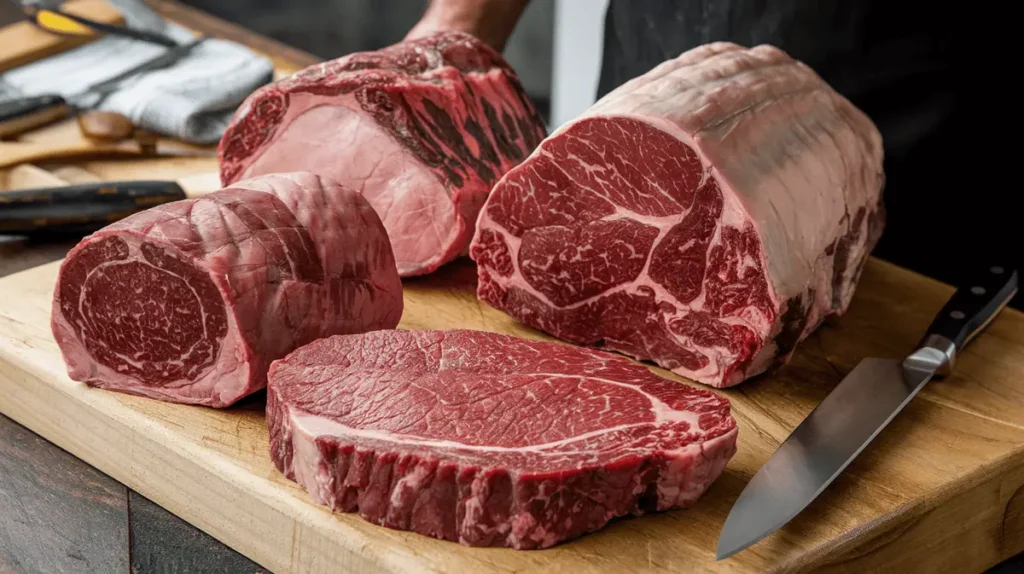
The quality of the beef used in beef sausage has a direct impact on the texture and taste. A blend of lean meat and fat is essential for maintaining moisture and preventing the sausage from becoming dry. Ideally, a ratio of 80% lean meat to 20% fat works well for homemade beef sausage, providing a juicy, tender bite without being overly greasy.
For the best results, opt for fresh cuts like chuck or brisket, as these have the right amount of marbling for a flavorful beef sausage. Grinding the beef at home allows for better control over texture, ensuring that the meat is not too coarse or too fine. If you’re unsure about the best cuts, explore Grinding the Beef to Get the Right Texture for expert recommendations.
When selecting beef, sourcing from a trusted butcher or high-quality grocery store ensures the freshest ingredients. Grass-fed beef is a great option for those looking for a richer flavor and healthier fat content. For additional cooking tips, check out Quick Juicy Perfect Steak – 30 Minutes to learn about meat selection and preparation techniques.
🛠️ Step-by-Step Guide: How to Make Beef Sausage
Making homemade sausage is a straightforward process that requires the right ingredients, tools, and techniques. By following these steps, you can ensure your sausages turn out flavorful, juicy, and perfectly textured. Proper preparation, grinding, seasoning, stuffing, and cooking will make all the difference in achieving the best results.
1️⃣ Step 1: Preparing Your Ingredients & Equipment
Before starting, gather all necessary ingredients and tools. You’ll need fresh beef, seasonings, sausage casings, a meat grinder, and a sausage stuffer. Ensuring that all ingredients are cold helps maintain the right texture and prevents the fat from smearing.
For best results, pre-measure the seasonings and chill the meat before grinding. If you’re unsure about the best spice combinations, explore Best Seasonings & Spices for Beef Sausage to create a well-balanced flavor profile.
To complement your homemade sausages, pair them with a fresh side dish. Check out Quick Easy Salad Recipes for light and refreshing options.
2️⃣ Step 2: Grinding the Beef to Get the Right Texture
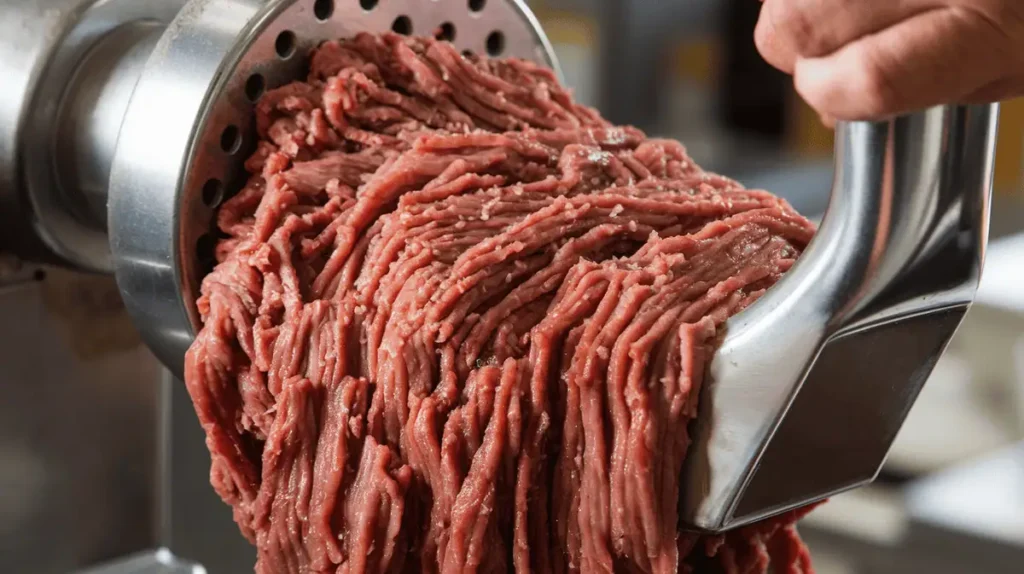
Grinding is one of the most important steps in sausage making. The ideal texture depends on the type of grind you use. A coarse grind creates a meatier bite, while a finer grind results in a smoother consistency.
Use a chilled grinder to keep the meat at a low temperature, which prevents fat from melting and ensures an even mixture. If you’re looking for expert recommendations, see Grinding the Beef to Get the Right Texture for tips on achieving the best consistency.
3️⃣ Step 3: Mixing the Spices & Seasoning for Flavorful Sausage
After grinding, it’s time to mix in the seasonings. Ensure the spices are evenly distributed throughout the meat to achieve consistent flavor. Mixing by hand or using a stand mixer with a paddle attachment can help blend everything thoroughly.
Letting the seasoned meat rest in the refrigerator for a few hours allows the flavors to develop. If you’re interested in refining your spice blend, explore Best Seasonings & Spices for Beef Sausage for additional seasoning ideas.
4️⃣ Step 4: Stuffing the Sausage Casings Like a Pro
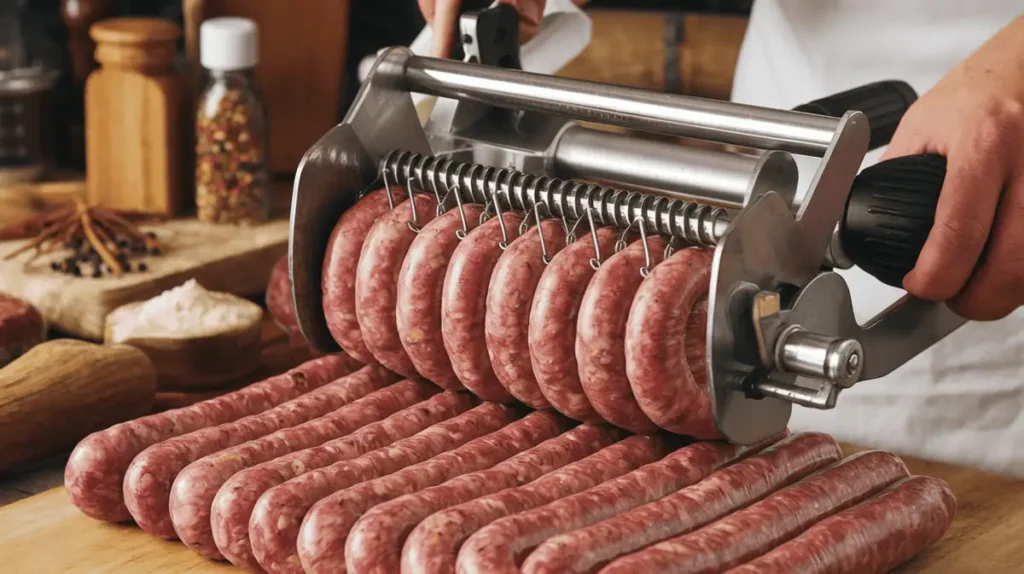
Stuffing the mixture into casings is a critical step in creating traditional sausages. Natural or synthetic casings can be used, depending on preference. A sausage stuffer provides the best results, ensuring even filling without air pockets.
To prevent bursting, avoid overfilling the casings. Twist them into links after stuffing, ensuring uniform size for even cooking. If you’re new to the process, learning proper stuffing techniques can make a big difference in the final texture.
5️⃣ Step 5: Cooking & Storing Your Homemade Beef Sausages
Once stuffed, the sausages are ready to be cooked or stored. They can be grilled, pan-fried, baked, or smoked, depending on preference. Slow cooking at a moderate temperature helps retain moisture and enhances flavor.
For long-term storage, freezing raw or cooked sausages in airtight packaging preserves freshness. If you’re unsure about proper storage techniques, check out How Long Can Beef Sausage Be Stored? for expert advice.
Homemade sausages can be used in a variety of dishes. For a delicious pairing idea, explore Quick Juicy Perfect Steak – 30 Minutes for meaty meal inspiration.
👩🍳 Pro Tips for Making the Best Beef Sausage
Creating flavorful and juicy beef sausage requires attention to detail. From balancing seasoning levels to choosing the right cooking methods, each step impacts the final taste and texture. By following these expert tips, you can ensure that your homemade sausages turn out perfectly every time.
✅ How to Prevent Dry or Overly Salty Sausages
One of the biggest challenges when making beef sausage is maintaining the right moisture level. If sausages turn out dry, it’s often due to an improper fat-to-meat ratio or overcooking. To achieve a tender texture, use a blend of 80% lean meat and 20% fat, ensuring that the fat binds with the meat for a juicy result. Grinding meat when it is cold also helps maintain a consistent texture.
Salt is another crucial factor. While it enhances flavor, too much can overpower the natural taste of the meat. To prevent overly salty sausages, always measure seasonings carefully. If adjusting a recipe, start with a lower amount and gradually increase based on taste. For the best spice balance, refer to Best Seasonings & Spices for Beef Sausage to find a well-rounded flavor profile.
Another technique for preventing dryness is adding liquid ingredients like broth, water, or crushed ice to the sausage mixture. This extra moisture keeps the sausage tender and enhances the mouthfeel. To learn more about seasoning balance and moisture retention, check out How to Prevent Dry or Overly Salty Sausages for additional tips.
✅ Best Cooking Methods for Juicy Beef Sausage
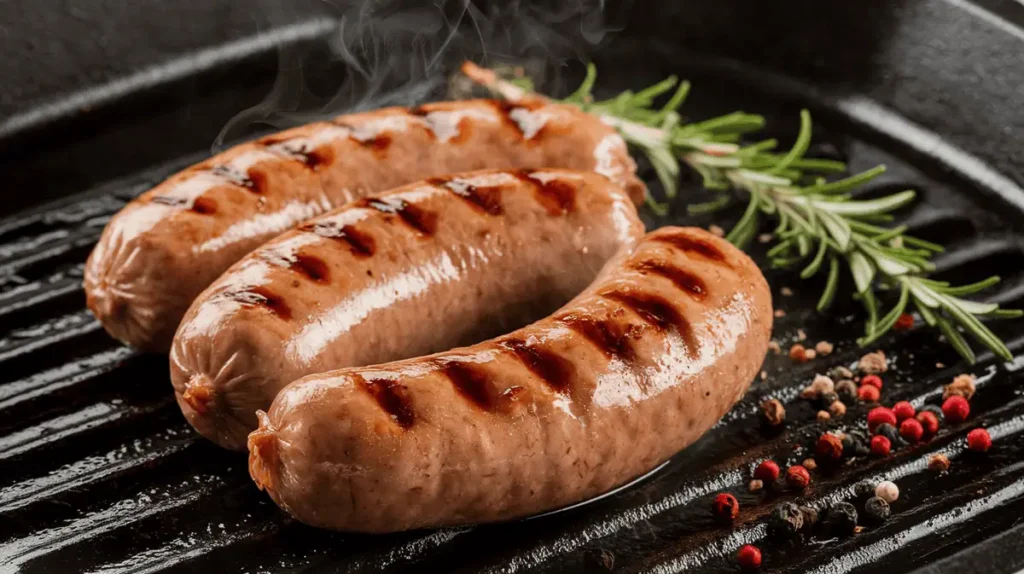
Choosing the right cooking method is key to keeping beef sausage juicy. Low and slow cooking methods, such as baking or slow grilling, help retain moisture while allowing flavors to develop fully. Pan-frying over medium heat with a little oil ensures a golden crust without drying out the inside.
Steaming before grilling is another effective technique. This method locks in moisture while ensuring even cooking. Additionally, smoking beef sausage at a low temperature infuses it with deep, rich flavor while preserving juiciness. If you’re interested in perfecting your cooking technique, refer to Best Cooking Methods for Juicy Beef Sausage for expert advice.
Pairing your sausage with complementary dishes can enhance the overall meal. Consider serving it with a fresh side like those in Quick Easy Salad Recipes for a well-balanced plate. If you’re looking for additional inspiration, check out Quick Juicy Perfect Steak – 30 Minutes to learn about meat preparation and cooking techniques.
📌 Common Mistakes to Avoid When Making Beef Sausage
Making beef sausage at home is a rewarding process, but small mistakes can affect the final texture, flavor, and juiciness. Avoiding these common pitfalls will help you achieve a perfectly balanced sausage that is both delicious and easy to prepare.
❌ Using the Wrong Meat-to-Fat Ratio
A beef sausage that is too dry or crumbly often results from an improper fat-to-meat ratio. The ideal blend is 80% lean beef and 20% fat, ensuring juiciness without being overly greasy. Using extra-lean beef can lead to dry, tough sausages, while excessive fat can cause a greasy texture. If you’re unsure about meat selection, check out Choosing the Right Beef for Sausage Making for expert recommendations.
❌ Overmixing the Sausage Mixture
While it’s important to evenly distribute seasonings, overmixing can lead to a dense and rubbery texture. Once the meat and spices are combined, mix just until everything is evenly incorporated. Overworking the mixture breaks down the fat and creates a tough sausage. For seasoning ideas, explore Best Seasonings & Spices for Beef Sausage to achieve the perfect balance.
❌ Grinding the Meat at the Wrong Temperature
Grinding meat when it’s too warm can cause the fat to smear, leading to a grainy texture. Always chill the beef and grinder parts before processing. This keeps the fat solid and helps maintain a proper texture. For more detailed grinding techniques, see Grinding the Beef to Get the Right Texture for step-by-step guidance.
❌ Stuffing the Casings Too Tight or Too Loose
Proper stuffing ensures that beef sausage holds its shape while remaining tender. Overstuffed casings can burst during cooking, while underfilled casings may create air pockets that affect the texture. To learn how to stuff casings correctly, check out Stuffing the Sausage Casings Like a Pro for best practices.
❌ Cooking at High Heat
High temperatures can cause sausages to dry out or split open. For the juiciest results, cook slowly over medium heat, whether pan-frying, grilling, or baking. Smoking at a low temperature is another great method for adding depth of flavor. If you’re looking for more cooking techniques, refer to Best Cooking Methods for Juicy Beef Sausage to perfect your approach.
By avoiding these common mistakes, you’ll create beef sausage that is flavorful, juicy, and well-textured every time. To pair your sausage with a refreshing side, check out Quick Easy Salad Recipes for meal inspiration.
🍽️ Serving Suggestions for Beef Sausages
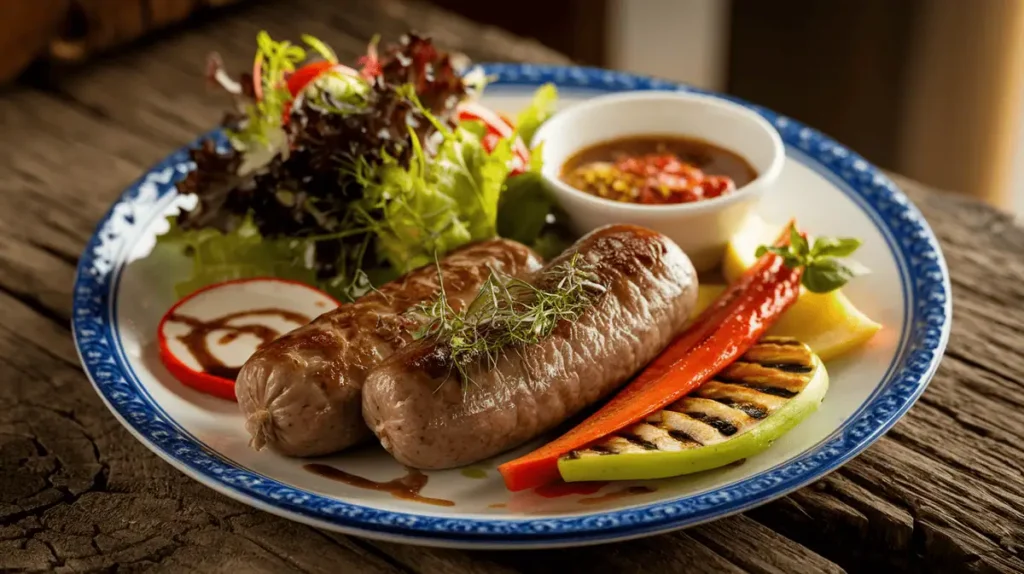
Homemade beef sausages offer endless possibilities for delicious meals. Whether you serve them at breakfast, lunch, or dinner, pairing them with the right sides enhances their flavor and texture.
🥗 Pair with Fresh Salads
A light and refreshing salad balances the richness of the sausages. Opt for a classic Greek salad, a tangy coleslaw, or a simple arugula and cherry tomato mix with balsamic dressing. If you’re looking for inspiration, check out Quick Easy Salad Recipes for fresh and vibrant options.
🍞 Serve in a Hearty Sandwich
Transform your sausages into a gourmet sandwich by slicing them and layering them in a toasted baguette or soft brioche bun. Add caramelized onions, mustard, and melted cheese for an irresistible meal. If you love sandwiches, explore Quick Gourmet Sandwiches – 5 Minutes for more creative ideas.
🍳 Enjoy with Classic Breakfast Sides
Beef sausages make a perfect addition to a hearty breakfast. Pair them with scrambled eggs, sautéed mushrooms, or crispy hash browns for a satisfying start to the day.
🍲 Incorporate into Main Dishes
Sliced beef sausages can be added to pasta, rice dishes, or stews to enhance their flavor. Try mixing them into a tomato-based sauce for a rich and comforting meal.
🍹 Pair with the Right Drinks
To complete the experience, pair your sausages with a refreshing homemade lemonade, a sparkling iced tea, or a bold espresso for a well-balanced meal.
By choosing the right accompaniments, you can elevate your homemade beef sausages into a gourmet dish that suits any occasion.
❓ FAQs About Beef Sausage
🔥 Can I Make Beef Sausages Without a Casing?
Yes, you can make beef sausage without casings. Many people refer to these as skinless sausages or sausage patties. Instead of stuffing the meat mixture into casings, shape it into patties or logs and cook it directly in a pan, oven, or on the grill. This method works well for those who prefer a simpler process or enjoy a more rustic texture.
To keep the sausage firm, chill the mixture before cooking. Adding natural binders like eggs or breadcrumbs also helps maintain the structure.
⏳ How Long Can You Store Sausage?
Store fresh sausage in the refrigerator at 4°C (40°F) or below, and use it within 2 to 3 days for the best freshness. If you vacuum-seal it or place it in an airtight container, you can extend its shelf life to 5 days. Cooked sausage stays fresh for up to 4 days in the fridge.
For longer storage, freezing remains the best option. When properly packaged, it holds its quality for several months. To learn more about the right freezing techniques, check out Can I Freeze Beef Sausages?
🥶 Can I Freeze Sausages?
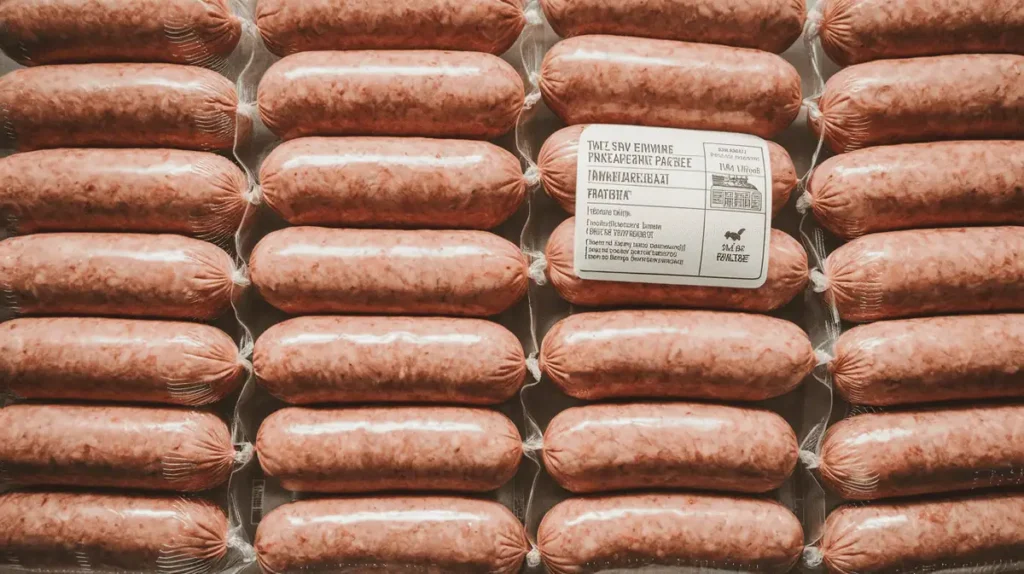
Yes, freezing helps preserve them for future meals. Wrap raw sausages tightly in freezer-safe packaging, such as vacuum-sealed bags or heavy-duty freezer wrap, to prevent freezer burn. When stored correctly, they stay fresh for up to 3 months. Cooked sausages can also go in the freezer, but you should thaw and reheat them carefully to maintain the best texture.
🥩 What’s the Best Beef Fat Ratio for Juicy Sausages?
Using 80% lean meat and 20% fat creates the ideal balance for beef sausage. This ratio keeps the sausage juicy while ensuring a firm texture. If you use too little fat, the sausage may turn out dry. Too much fat can make it greasy.
To get the best results, choose well-marbled cuts like chuck or brisket. Grinding the meat while it is cold helps maintain the right texture and prevents the fat from smearing.
🚀 Conclusion – Start Making Delicious Beef Sausage Today!
Now is the perfect time to master beef sausage making at home. When you choose high-quality ingredients, grind your own meat, and mix the right seasonings, you create a sausage with unbeatable flavor and texture. Every step, from preparation to cooking, lets you control the quality and taste, ensuring a delicious result without artificial additives.
Creating beef sausage from scratch brings a deep sense of satisfaction. Whether you grill, pan-fry, or smoke them, you unlock endless possibilities for flavorful meals. Serve them in sandwiches, pair them with fresh salads, or make them the highlight of your next family dinner. Each bite reflects the care and skill you put into your cooking.
Start today! Gather your ingredients, follow this step-by-step guide, and enjoy the rich taste of homemade beef sausage. If you want to refine your cooking techniques, explore Best Cooking Methods for Juicy Beef Sausage and take your sausages to the next level!

